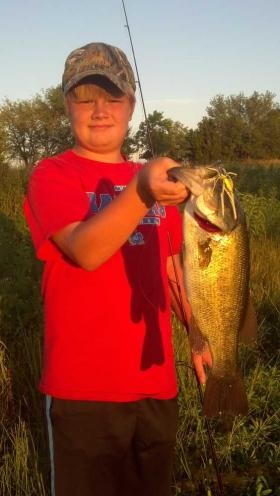 The Topeka Capital-Journalreported 1st: There’s little doubt everyone has heard of Dr. Seuss. And this week is especially poignant regarding the man responsible for teaching many kids some of life’s greatest lessons. He was born 112 years ago last Wednesday. He died in 1991 at the age of 87.
The Topeka Capital-Journalreported 1st: There’s little doubt everyone has heard of Dr. Seuss. And this week is especially poignant regarding the man responsible for teaching many kids some of life’s greatest lessons. He was born 112 years ago last Wednesday. He died in 1991 at the age of 87.

A man of many talents, Dr. Seuss was a writer/illustrator who wrote numerous children’s books that were a staple for many youngsters growing up. He even wrote about the outdoors a little bit, too, and had a great fishing book called “One Fish, Two Fish, Red Fish, Blue Fish.”
So, to honor Dr. Seuss and his legacy, here’s my own personal tribute to his famous “fish” book, originally published in 1960.
ONE FISH!
When it comes to popularity among Kansas anglers, the largemouth bass is king, according to Doug Nygren, director of the Fisheries Division of the Kansas Department of Wildlife, Parks and Tourism.
“I think there’s been a lot of good marketing by folks in the bait and tackle business, television and media outlets promoting bass fishing,” Nygren said as to the reason for their top billing. “You don’t just sit there and wait, you’re active and it’s an exciting way to fish, so I think that’s a lot of the attraction.”
Best bets for catching largemouth bass this year, according to the 2016 Kansas Fishing Forecast, include Sebelius (Norton), LaCygne and Big Hill reservoirs. The state record largemouth bass was caught in a private pit in Cherokee County in 2008 by Tyson Hallam. It weighed 11.80 pounds.
TWO FISH!
While some anglers pursuing the No. 1 rated sport fish in Kansas wouldn’t dare dream of eating their catch, anglers looking for Kansas’ runner-up sport fish don’t have any problem doing just that.
“Crappie are number two on the list,” Nygren said of preferred fish species.
Crappie are prolific spawners and many reservoirs, as well as smaller community and state fishing lakes, produce plenty of crappie for anglers to take home and eat. Many anglers rank their palatability behind only walleye as far as flavor and texture.
Kansas has two species of crappie, the black and white crappie, with the latter being the most common in larger bodies of water. Best bets for catching white crappie this year, according to the 2016 Kansas Fishing Forecast, include John Redmond, Toronto and Elk City reservoirs. The state record white crappie was caught in a Greenwood County pond in 1964 by Frank Miller and weighed 4.02 pounds. Read more of this article by Marc Murrell here –
